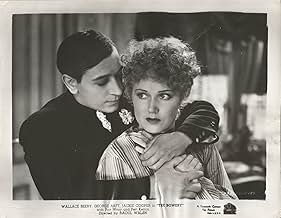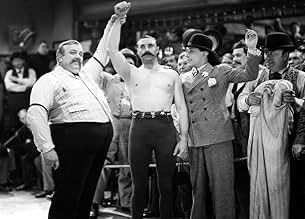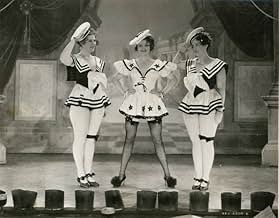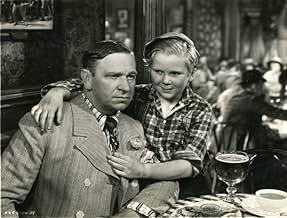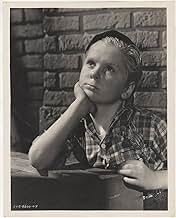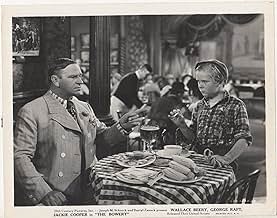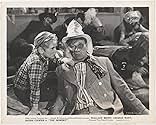Principios del siglo XX. Narra una historia ambientada en el siglo XIX en Bowery, un popular barrio de Nueva York habitado por gángsteres, matones y prostitutas.Principios del siglo XX. Narra una historia ambientada en el siglo XIX en Bowery, un popular barrio de Nueva York habitado por gángsteres, matones y prostitutas.Principios del siglo XX. Narra una historia ambientada en el siglo XIX en Bowery, un popular barrio de Nueva York habitado por gángsteres, matones y prostitutas.
- Dirección
- Guión
- Reparto principal
- Premios
- 3 premios en total
Bull Anderson
- Pug
- (sin acreditar)
Irving Bacon
- Hick
- (sin acreditar)
Lucille Ball
- Blonde
- (sin acreditar)
John Bleifer
- Mumbo the Mute
- (sin acreditar)
Phil Bloom
- Pug
- (sin acreditar)
James Burke
- Recruiting Sergeant
- (sin acreditar)
Marguerite Caverley
- Undetermined Secondary Role
- (sin acreditar)
Reseñas destacadas
High energy Raoul Walsh classic from 1933, The Bowery places saloon owner and operator Wallace Beery against bitter rival and dandy, George Raft, with adopted street kid Jackie Cooper and good looking Faye Wray in roles that play in between their big rivalry. It's not clear exactly what the rivalry is all about, but everyone follows it in the daily tabloids. Plenty of wisecracks at the beginning, but the characters soften up as the film progresses. Apart from that is the sheer exuberance of the scenes in Beery's saloon. The various characters, sexy chorus line, lots of drinking, a perfect creation of a den of iniquity not too refrained by so-called pre-code restrictions, and then later come the Carrie Nations led by Carrie Nation herself. It all creates a very vivid picture of a life that's long gone. I don't like to compare eras, but this film is completely and totally different from anything one would see today. The film has plenty of heart and long lost innocence and is absolutlely a must see.
"The Bowery", along with "Me and My Gal"(1932), is probably director Raoul Walsh's best film at Fox. This is a one Walsh picture that will appeal to all kinds of audiences and perhaps turn you into a devoted Walsh enthusiast. I've always been a big Walsh fanatic and "Bowery" is one of few of his pictures that has eluded for quite some time. I finally saw it and was blown away by it.
"Bowery" is also Walsh's best film of 1933, easily eclipsing the ponderous "Going Hollywood". Inspired by Mae West's hugely successful comedy-riot "She Done Him Wrong", Walsh rightfully turned this pre-Code frolic into his own. All the Walsh touches are here in full bloom: the rousing ebullience & energy, the portrait of everyday life, the sheer innocence of its characters, the nostalgic evocation of the Gay 90s (Walsh's own impressionable years), and the unsophisticated resort to ribald humor, brawls, and jocularity. It also features John L. Sullavan, Errol Flynn's famous opponent in Walsh's 1942 boxing classic "Gentleman Jim".
George Raft and Wallace Beery are excellent as the two rivals in New York's Bowery of the 1890s. They are fighting for the love of Fay Wray (always a welcome sight). Jackie Cooper, playing the streetwise rascal, reunites with Beery after their successful teaming in Vidor's "The Champ" and it is great to watch them again.
Ultimately, though, it is Walsh's sheer exuberance that counts the most. "Bowery" is one of my all-time favorite films, the kind of picture that you would like to watch again and again. A must if you get a chance to see it.
"Bowery" is also Walsh's best film of 1933, easily eclipsing the ponderous "Going Hollywood". Inspired by Mae West's hugely successful comedy-riot "She Done Him Wrong", Walsh rightfully turned this pre-Code frolic into his own. All the Walsh touches are here in full bloom: the rousing ebullience & energy, the portrait of everyday life, the sheer innocence of its characters, the nostalgic evocation of the Gay 90s (Walsh's own impressionable years), and the unsophisticated resort to ribald humor, brawls, and jocularity. It also features John L. Sullavan, Errol Flynn's famous opponent in Walsh's 1942 boxing classic "Gentleman Jim".
George Raft and Wallace Beery are excellent as the two rivals in New York's Bowery of the 1890s. They are fighting for the love of Fay Wray (always a welcome sight). Jackie Cooper, playing the streetwise rascal, reunites with Beery after their successful teaming in Vidor's "The Champ" and it is great to watch them again.
Ultimately, though, it is Walsh's sheer exuberance that counts the most. "Bowery" is one of my all-time favorite films, the kind of picture that you would like to watch again and again. A must if you get a chance to see it.
George Raft as Steve Brodie, the carefree, dancing gambler who can never refuse a dare, is pitted against the lumbering, sentimental, Chuck Connors (Wallace Beery).A soft touch for every panhandler, Connors impulsively adopts waifs and strays, notably runaway orphan "Swipes" (Jackie Cooper, complete with kittens!) and the homeless Lucy Calhoun, an out-of-town innocent with ambitions to become a writer.
In this male-dominated culture, communication takes place mostly in the form of violence (one sees why THE BOWERY is a Martin Scorsese favorite). Exploding cigars provide a running gag. "Swipes" enjoys throwing rocks through windows in Chinatown, on one occasion setting a laundry alight. (The simultaneous arrival of both Brodie's and Beery's volunteer fire companies leads to a brawl, during which the building burns to the ground.) Beery casually saps a troublesome girl, and thumps anyone who disagrees with him, including Brodie, whom he defeats, in a night-time fist fight on a moored barge, to regain control of his saloon, lost on a bet that Brodie wouldn't have the courage to jump off the Brooklyn Bridge. (Brodie does make the leap, but only because a subterfuge with a dummy fails at the last moment.)
As usual, Walsh fills the frame with detail, illustrating with relish the daily life of the tenderloin; singing waiters, bullying barmen, whores from Suicide Hall being hustled into the Black Maria, tailors collaring hapless hicks off the street and forcing them to buy suits they don't want. A minor but admirable little film.
In this male-dominated culture, communication takes place mostly in the form of violence (one sees why THE BOWERY is a Martin Scorsese favorite). Exploding cigars provide a running gag. "Swipes" enjoys throwing rocks through windows in Chinatown, on one occasion setting a laundry alight. (The simultaneous arrival of both Brodie's and Beery's volunteer fire companies leads to a brawl, during which the building burns to the ground.) Beery casually saps a troublesome girl, and thumps anyone who disagrees with him, including Brodie, whom he defeats, in a night-time fist fight on a moored barge, to regain control of his saloon, lost on a bet that Brodie wouldn't have the courage to jump off the Brooklyn Bridge. (Brodie does make the leap, but only because a subterfuge with a dummy fails at the last moment.)
As usual, Walsh fills the frame with detail, illustrating with relish the daily life of the tenderloin; singing waiters, bullying barmen, whores from Suicide Hall being hustled into the Black Maria, tailors collaring hapless hicks off the street and forcing them to buy suits they don't want. A minor but admirable little film.
A favourite of mine,this movie tells of two feuding New York "characters", Steve Brodie(Raft) and "Chuck" Connors(Beery),who both strive to be the "Main Guy" in the Bowery in the late Nineteenth Century.
Brodie(1863-1901) and Connors(1852-1913),were real people,though this is a heavily fictionalized account of their antics(based on a play).Brodie's legendary(did he do it?- it's still a cause of argument!),jump from the Brooklyn bridge(1886),for which he became famous,is shown here as happening around the same time as the Spanish-American war(1898).Director Walsh clearly had a great affection for the period,so beautifully recreated here,and it includes a wild rumbustious ragtime number from saloon singer Trixie Odbray(a young Pert Kelton).Raft is at his slickest as Brodie,and Beery shows again what a clever actor he was,as tough, big hearted, and at times quite touching Connors.Pretty Fay Wray is the love interest both the boys are pursuing.
Full of life and energy,"The Bowery" moves at a fast pace(unlike many early "talkies").It is not an easy movie to find,but is well worth looking out for.
Brodie(1863-1901) and Connors(1852-1913),were real people,though this is a heavily fictionalized account of their antics(based on a play).Brodie's legendary(did he do it?- it's still a cause of argument!),jump from the Brooklyn bridge(1886),for which he became famous,is shown here as happening around the same time as the Spanish-American war(1898).Director Walsh clearly had a great affection for the period,so beautifully recreated here,and it includes a wild rumbustious ragtime number from saloon singer Trixie Odbray(a young Pert Kelton).Raft is at his slickest as Brodie,and Beery shows again what a clever actor he was,as tough, big hearted, and at times quite touching Connors.Pretty Fay Wray is the love interest both the boys are pursuing.
Full of life and energy,"The Bowery" moves at a fast pace(unlike many early "talkies").It is not an easy movie to find,but is well worth looking out for.
In his new 20th Century Pictures Corporation which was at the time releasing its product with United Artists, Darryl F. Zanuck almost had an MGM trifecta for his stars. Wallace Beery and Jackie Cooper came from MGM and Clark Gable almost did. But according to the biography of George Raft from James Parrish, Raft wanted very much to do this film and Zanuck accommodated him and got him from Paramount.
It was a wise move on Zanuck's part because Steve Brodie of the Bowery was a part Raft was born to play. And why not since Raft grew up in the Hell's Kitchen area of New York and knew the scene well.
As did Raoul Walsh who was born and raised in Rockaway Beach, New York and also knew the red light areas of the city well. The best thing that The Bowery has going for it was is the incredible detail in terms of creating the atmosphere of the Gay Nineties in one of New York's most colorful areas. In fact so much detail was presented that the film is rarely seen today for all the racial epithets it has. But that would be true of the era. Racial and ethnic stereotyping was the rule of the day. In fact Ragtime is also quite graphic in that, the difference being the point of view that film takes.
What The Bowery has in atmosphere with its sets, dialog with the idioms of the day, and costumes, it loses in accuracy. Set in 1897-98 before the Spanish American War it has the legendary Steve Brodie doing his jump off the Brooklyn Bridge at that time. In point of fact it was in 1886.
Raft as Brodie and Beery as Chuck Connors are a pair of friendly if caustic rivals of The Bowery area in lower Manhattan. The two are forever trying to top each other and that is given as the reason for Raft doing his famous dive off the Brooklyn Bridge and living to tell about it. Actually there is cause in real life to think Brodie never did the deed. And in fact some question is raised in Beery's mind which leads to the climax of The Bowery.
Jackie Cooper's well known antipathy to Beery has been documented, but in the Parrish book on Raft during a fight scene Beery got a little rougher than the script called for. Raft then responded with what is described as a roundhouse right into the family jewels. Beery reacted normally as one does when one is hit there.
If one values political correctness than do not see this film. But otherwise it is an all too accurate a look on a bygone era.
It was a wise move on Zanuck's part because Steve Brodie of the Bowery was a part Raft was born to play. And why not since Raft grew up in the Hell's Kitchen area of New York and knew the scene well.
As did Raoul Walsh who was born and raised in Rockaway Beach, New York and also knew the red light areas of the city well. The best thing that The Bowery has going for it was is the incredible detail in terms of creating the atmosphere of the Gay Nineties in one of New York's most colorful areas. In fact so much detail was presented that the film is rarely seen today for all the racial epithets it has. But that would be true of the era. Racial and ethnic stereotyping was the rule of the day. In fact Ragtime is also quite graphic in that, the difference being the point of view that film takes.
What The Bowery has in atmosphere with its sets, dialog with the idioms of the day, and costumes, it loses in accuracy. Set in 1897-98 before the Spanish American War it has the legendary Steve Brodie doing his jump off the Brooklyn Bridge at that time. In point of fact it was in 1886.
Raft as Brodie and Beery as Chuck Connors are a pair of friendly if caustic rivals of The Bowery area in lower Manhattan. The two are forever trying to top each other and that is given as the reason for Raft doing his famous dive off the Brooklyn Bridge and living to tell about it. Actually there is cause in real life to think Brodie never did the deed. And in fact some question is raised in Beery's mind which leads to the climax of The Bowery.
Jackie Cooper's well known antipathy to Beery has been documented, but in the Parrish book on Raft during a fight scene Beery got a little rougher than the script called for. Raft then responded with what is described as a roundhouse right into the family jewels. Beery reacted normally as one does when one is hit there.
If one values political correctness than do not see this film. But otherwise it is an all too accurate a look on a bygone era.
¿Sabías que...?
- CuriosidadesGeorge Raft and Wallace Beery were at odds during filming. According to Raft, before the fistfight scene, Beery asked Raft to let him throw the first punch and then proceeded to sucker-punch Raft, knocking him out for several minutes. "When I came to I got up and called him everything I could think of," Raft said. They then fought for real, and the crew had to break it up.
- PifiasThe name of George Raft's character, "Steve Brodie," is misspelled "Brody" in the opening credits.
- Citas
Steve Brodie: Don't ever say I never give ya nothin'.
- Versiones alternativasThe version shown on Fox Movie Channel runs seven seconds over 87 minutes. Apparently it is a reissue copy, the missing five minutes due to reediting to fit post code rules. Though it was made for Twentieth Century Films, a new start up film studio organized by Joe Schenck, Bill Goetz (L.B. Mayer's son-in-law) and ex-Warner Bros. production chief Darryl Zanuck, the FMC version is presented under the post merger logo of Twentieth Century Fox complete with fanfare and an end title crediting distribution to TCF. This year a full uncut version was shown at New York's Film Forum which clocked several minutes over ninety minutes.
- ConexionesEdited into Brooklyn Bridge (1981)
- Banda sonoraThe Bowery
(uncredited)
Music by Percy Gaunt
Lyrics by Charles Hale Hoyt
Sung by a chorus at the beginning
Played often in the score
Selecciones populares
Inicia sesión para calificar y añadir a tu lista para recibir recomendaciones personalizadas
- How long is The Bowery?Con tecnología de Alexa
Detalles
Taquilla
- Presupuesto
- 421.496 US$ (estimación)
- Duración1 hora 32 minutos
- Color
- Relación de aspecto
- 1.37 : 1
Contribuir a esta página
Sugerir un cambio o añadir el contenido que falta

